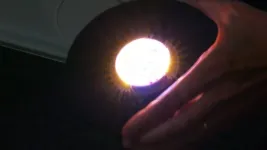(Press-News.org) Those mesmerizing blue and orange hues in the sky at the start and end of a sunny day might have an essential role in setting humans’ internal clocks.
In new research from the University of Washington in Seattle, a novel LED light that emits alternating wavelengths of orange and blue outpaced two other light devices in advancing melatonin levels in a small group of study participants.
Published in the Journal of Biological Rhythms, the finding appears to establish a new benchmark in humans’ ability to influence their circadian rhythms, and reflects an effective new approach to counteract seasonal affective disorder (SAD).
A raft of health and mood problems have been attributed to out-of-sync circadian rhythms. Such asynchrony is encouraged by seasonal changes, a lack of exposure to natural light, graveyard-shift jobs and flights across multiple time zones.
“Our internal clock tells us how our body's supposed to act during different times of day, but the clock has to be set, and if our brain is not synced to the time of day, then it's not going to work right,” said Jay Neitz, a coauthor on the paper and a professor of ophthalmology at the UW School of Medicine.
Circadian rhythms are trained and reset every day by the 24-hour solar cycles of light and dark, which stimulate circuits in the eyes that communicate to the brain. With that information, the brain produces melatonin, a hormone that helps organisms become sleepy in sync with the solar night.
People who spend many daily hours in artificial light often have circadian rhythms whose melatonin production lags that of people more exposed to natural light. Many commercial lighting products are designed to offset or counteract these lags.
Most of these products, Neitz said, emphasize blue wavelength because it is known to affect melanopsin, a photopigment in the eyes that communicates with the brain and is most sensitive to blue.
By contrast, “the light we developed does not involve the melanopsin photopigment,” Neitz explained. “It has alternating blue and orange wavelengths that stimulate a blue-yellow opponent circuit that operates through the cone photoreceptors in the retina. This circuit is much more sensitive than melanopsin, and it is what our brains use to reset our internal clocks.”
The paper's lead author was James Kuchenbecker, a research assistant professor of ophthalmology at the UW School of Medicine. He sought to compare different artificial lights’ effects on the production of melatonin.
He and colleagues devised and conducted a test of three devices:
a white light of 500 lux (a brightness appropriate for general office spaces)
a short-wavelength blue LED designed to trigger melanopsin
the newly developed LED of blue and orange wavelengths, which alternate 19 times a second to generate a soft white glow
The goal was to see what lighting approach was most effective at advancing the phase of melatonin production among six study participants. All participants underwent the following regimen with exposure to each of the three test lights:
The first evening, multiple saliva samples were taken to discern the baseline onset and peak of the participants’ melatonin production. For each subject, the onset of this phase dictated when they were exposed to the test light for two hours in the morning. That evening, saliva samples were again taken to see whether subjects’ melatonin phase had started earlier relative to their individual baselines.
During each test, exposure to other light sources was controlled. The three test spans were spaced such that subjects could return to their normal baseline phases before starting a new device.
In terms of shifting the melatonin-production phase, the alternating blue-orange LED device worked best, with a phase advance of 1 hour, 20 minutes. The blue light produced a phase advance of 40 minutes. The white, 500-lux light elicited an advance of just 2.8 minutes.
Gesturing toward the light that his team developed, Neitz explained.
“Even though our light looks like white to the naked eye, we think your brain recognizes the alternating blue and orange wavelengths as the colors in the sky. The circuit that produced the biggest shift in melatonin wants to see orange and blue.”
The research was supported by the National Institutes of Health (R01 EY027859, P30EY001730 and T32EY007031).
Through the UW, Neitz and Kuchenbecker commercialized the light technology, which is manufactured and sold by a Chicago-based company, TUO.
###
END
Scientists mix sky’s splendid hues to reset circadian clocks
In a small study, a novel LED device with alternating orange and blue wavelengths outpaced two other lights in advancing participants’ melatonin levels
2024-09-16
ELSE PRESS RELEASES FROM THIS DATE:
Society for Neuroscience 2024 Outstanding Career and Research Achievements
2024-09-16
Embargoed until Monday, September 16, noon EDT Contact: development@sfn.org
CHICAGO – The Society of Neuroscience (SfN) will honor leading researchers whose groundbreaking work has transformed neuroscience — including the understanding of pain, addiction, stress, synaptic transport, vision, and sleep — with this year’s Outstanding Career and Research Achievement Awards. The awards will be presented during SfN’s annual ...
Society for Neuroscience 2024 Early Career Scientists’ Achievements and Research Awards
2024-09-16
Embargoed until Monday, September 16, noon EDT Contact: development@sfn.org
CHICAGO – The Society for Neuroscience (SfN) will honor nine early career researchers whose work will be presented during Neuroscience 2024, SfN's annual meeting.
“Early career researchers are often the ones who bring fresh ideas and perspectives to the field,” said SfN President Marina Picciotto. “These awardees and their novel approaches to microscopy, machine learning, circuits and behavior ...
Society for Neuroscience 2024 Education and Outreach Awards
2024-09-16
Embargoed until Monday, September 16, noon EDT Contact: development@sfn.org
CHICAGO – The Society for Neuroscience (SfN) will present six neuroscientists with this year’s Science Education and Outreach Awards, comprising the Award for Education in Neuroscience, the Science Educator Award, and the Next Generation Awards. The awards will be presented during SfN’s annual meeting.
“The Society is honored to recognize these passionate neuroscientists ...
Society for Neuroscience 2024 Promotion of Women in Neuroscience Awards
2024-09-16
Embargoed until Monday, September 16, noon EDT Contact: development@sfn.org
CHICAGO — The Society for Neuroscience (SfN) will honor seven researchers who have made significant contributions to the advancement of women in neuroscience. The awards will be presented during Neuroscience 2024, SfN's annual meeting.
“Neuroscience is both a field of research and a community of researchers,” said SfN President Marina Picciotto. “These awardees not only advance our field’s understanding of the brain through their own research, they strengthen and support ...
Baek conducting air quality monitoring & simulation analysis
2024-09-16
Baek Conducting Air Quality Monitoring & Simulation Analysis
B.H. Baek, Research Associate Professor, Center for Spatial Information Science and Systems, College of Science, received funding for: “EPA Air Quality Modeling and Simulation Analysis (AQM- Office of Air Quality, Planning Standards (OAQPS) Program.”
Baek will perform work in support of the U.S. EPA Office of Air Quality Policy and Standards (OAQPS) Air Quality Modeling and Simulation Analysis.
Baek received $27,316 from General ...
Albanese receives funding for scholarship grant program
2024-09-16
Massimiliano Albanese, Associate Professor, Information Sciences and Technology; Associate Chair for Research, School of Computing; College of Engineering and Computing (CEC), received funding for: “DoD Cyber Scholarship Grant Program.”
George Mason will continue administering its Cybersecurity Scholarship Program during the 2024-2025 academic year, under the Department of Defense (DoD) Cyber Service Academy (CSA) program, formerly known as the DoD Cybersecurity Scholarship Program (CySP).
The objective ...
Generative AI model study shows no racial or sex differences in opioid recommendations for treating pain
2024-09-16
A new study from Mass General Brigham researchers provides evidence that large language models (LLMs), used for generative artificial intelligence (AI), ChatGPT-4 and Google’s Gemini, demonstrated no differences in suggested opioid treatment regimens for different races or sexes. Results are published in PAIN.
“I see AI algorithms in the short term as augmenting tools that can essentially serve as a second set of eyes, running in parallel with medical professionals,” said corresponding author Marc Succi, ...
New study links neighborhood food access to child obesity risk
2024-09-16
Key Takeaways:
A new study led by the Harvard Pilgrim Health Care Institute examined whether neighborhood food access in early life is associated with trajectories of child body mass index and obesity risk.
Study results show that neighborhood food access matters. Residing in low-income, low-food-access neighborhoods during pregnancy or early childhood is linked to a higher body mass index (BMI) z-score and a more than 50% increased risk of obesity and severe obesity from childhood to adolescence.
Investing in neighborhood resources to improve food access ...
Efficacy and safety of erenumab for nonopioid medication overuse headache in chronic migraine
2024-09-16
About The Study: In this study, monthly, 140 mg erenumab injections safely and effectively achieved medication overuse headaches remission in patients with nonopioid chronic migraine and medication overuse headaches within 6 months.
Quote from corresponding author Stewart J. Tepper, MD:
“Those patients with medication overuse headache (MOH) have higher disability and a significant unmet clinical need. Erenumab proved effective versus placebo in significantly higher rates of MOH remission and marked reduction in days in which acute migraine treatment was taken in a randomized controlled trial, with these benefits sustained through ...
Air pollution and Parkinson disease in a population-based study
2024-09-16
About The Study: The findings of this study suggest that a reduction in air pollution may help reduce Parkinson disease risk, modifying the Parkinson disease phenotype and the risk of dyskinesia in patients with Parkinson disease.
Corresponding Authors: To contact the corresponding authors, email Brittany Krzyzanowski, PhD, (brittany.krzyzanowski@barrowneuro.org) and Rodolfo Savica, MD, PhD, (savica.rodolfo@mayo.edu).
To access the embargoed study: Visit our For The Media website at this link https://media.jamanetwork.com/
(doi:10.1001/jamanetworkopen.2024.33602)
Editor’s ...
LAST 30 PRESS RELEASES:
Injectable breast ‘implant’ offers alternative to traditional surgeries
Neuroscientists devise formulas to measure multilingualism
New prostate cancer trial seeks to reduce toxicity without sacrificing efficacy
Geometry shapes life
A CRISPR screen reveals many previously unrecognized genes required for brain development and a new neurodevelopmental disorder
Hot flush treatment has anti-breast cancer activity, study finds
Securing AI systems against growing cybersecurity threats
Longest observation of an active solar region
Why nail-biting, procrastination and other self-sabotaging behaviors are rooted in survival instincts
Regional variations in mechanical properties of porcine leptomeninges
Artificial empathy in therapy and healthcare: advancements in interpersonal interaction technologies
Why some brains switch gears more efficiently than others
UVA’s Jundong Li wins ICDM’S 2025 Tao Li Award for data mining, machine learning
UVA’s low-power, high-performance computer power player Mircea Stan earns National Academy of Inventors fellowship
Not playing by the rules: USU researcher explores filamentous algae dynamics in rivers
Do our body clocks influence our risk of dementia?
Anthropologists offer new evidence of bipedalism in long-debated fossil discovery
Safer receipt paper from wood
Dosage-sensitive genes suggest no whole-genome duplications in ancestral angiosperm
First ancient human herpesvirus genomes document their deep history with humans
Why Some Bacteria Survive Antibiotics and How to Stop Them - New study reveals that bacteria can survive antibiotic treatment through two fundamentally different “shutdown modes”
UCLA study links scar healing to dangerous placenta condition
CHANGE-seq-BE finds off-target changes in the genome from base editors
The Journal of Nuclear Medicine Ahead-of-Print Tip Sheet: January 2, 2026
Delayed or absent first dose of measles, mumps, and rubella vaccination
Trends in US preterm birth rates by household income and race and ethnicity
Study identifies potential biomarker linked to progression and brain inflammation in multiple sclerosis
Many mothers in Norway do not show up for postnatal check-ups
Researchers want to find out why quick clay is so unstable
Superradiant spins show teamwork at the quantum scale
[Press-News.org] Scientists mix sky’s splendid hues to reset circadian clocksIn a small study, a novel LED device with alternating orange and blue wavelengths outpaced two other lights in advancing participants’ melatonin levels

